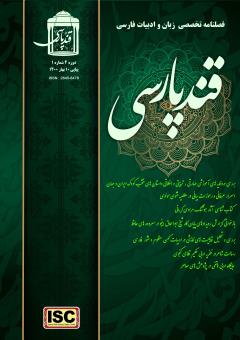اسرار عرفانی و رموزات بیانی در مطلعیه مثنوی مولوی
محورهای موضوعی : تحلیل متون نظم
فاضل عباس اده
1
![]() ,
مهرداد آقائی
2
,
مهرداد آقائی
2
![]()
1 - دانشگاه آزاد پارس آباد
2 - ادبیات و علوم انسانی
کلید واژه: مولوی مثنویحکایتشکایت اسرار عرفانی نی.,
چکیده مقاله :
مولانا در طلیعه مثنوی با نوای دلکش و ناله های خالصانه نی، عطش عرفانی جدایی روح معنوی را از اصل خود با زبان سوزناک نی شرحه شرحه بیان می کند. این -نامه عصاره ای از شش دفتر مثنوی معنوی و نیز براعت استهلالی بر تمامی اشعار این گنجینة ادبی و عرفانی است که از همان آغاز تصویری از فراق و هجران ترسیم می کند. نکته ای که قابل تأمل است مفهوم واژ ه های «حکایت» و «شکایت» در بیت آغازین مثنوی است که شارحان متعددی اقدام به شرح آن نموده و هر کدام تفسیری خاص از آن داشته اند. این مقاله بر آن است با روش توصیفی- تحلیلی برخی از معانی مطرح شده توسط تعدادی از شارحان را مورد ارزیابی و نقد قرار داده و در اثبات معانی و مفهوم ادعایی، موضوع را در دو محور بافت عمودی نی نامه و بافت تناسبی و تناقضی واژه با منازل، وادی ها و مقامات عرفانی، مورد بحث و تحلیل قرار دهد. نتایج پژوهش حاکی از این است که مباحث عرفانی در هر اثر ادبی، از جمله مثنوی معنوی، آن چنان گسترده و پرمحتواست که هرکسی به قدر و توان دانش خود می تواند آن را درک کند. مفهوم «شکایت» در نی نامه شکایت اعتراض آمیز نیست که برخی از شارحان آن را بیان کرده اند، بلکه «نفیر» جدایی، «شرح درد اشتیاق» و «ناله» و مناجات عاشقانه ای است که مولوی در محور عمودی شعر آن را رمزگشایی کرده است.
At the beginning of the Masnavi, Rumi describes the mystical thirst for the separation of the spiritual soul from its origin with the sorrowful language of the reed, with the heartfelt melody and sincere sighs of the reed. This letter is an excerpt from the six books of the spiritual Masnavi and also an explicit proof of all the poems of this literary and mystical treasure, which paints a picture of separation and mourning from the very beginning. The point to be considered is the meaning of the words "anecdote" and "complaint" in the first verse of Masnavi, which has been described by several commentators and each of them has had a specific interpretation of it. This article intends to evaluate and critique some of the meanings proposed by a number of commentators by descriptive-analytical method and in proving the alleged meanings and concepts, the subject is divided into two axes: the vertical context of the letter and the proportional and contradictory context of the word. Discuss and analyze with mystical houses, valleys and authorities. The results of the research indicate that the mystical topics in any literary work, including the spiritual Masnavi, are so extensive and rich in content that everyone can understand it to the best of their knowledge. The concept of "complaint" in the letter is not a protest complaint expressed by some commentators, but "disgust" of separation, "description of the pain of longing" and "lamentation" and romantic prayers that Rumi in the vertical axis of its poetry. Has decrypted.
